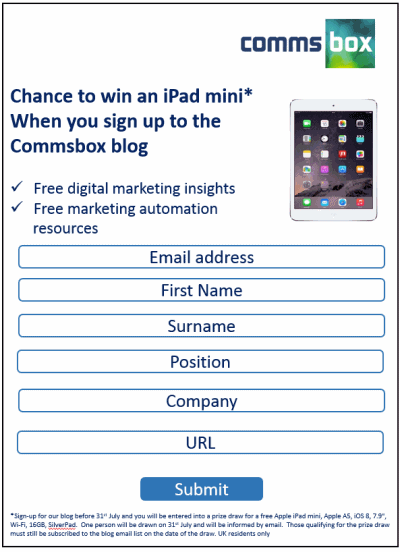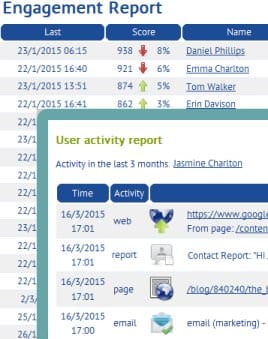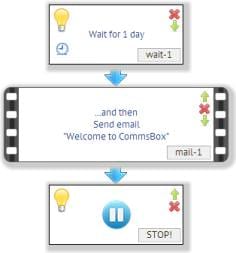How to compare Marketing Automation vendors
Marketing Automation is now one of the most commercially important techniques for digital marketers, so you have to look to select the most cost-effective platforms. But how do you tell one supplier from the other, and how do you know which will best help you meet your objectives in the most cost-effective way?
If you are currently making the case for marketing automation, here are 10 questions you should ask any vendor before making your choice.
1. How will it help me to drive leads to my business?
We know today’s consumers look for relevant products and services as and when they need them. Frequent, fresh, high quality content on your website, blog or social media will attract visitors when the time is right for them to buy. Marketing automation software helps you to turn those visitors into leads by asking visitors to leave their contact details in exchange for something else more valuable.
The first question you should ask is whether the solution can be integrated with your website or is only available as standalone landing pages. Standalone landing pages can help you to drive home a message without the user getting distracted by the site menu. However, marketing automation forms that are integrated with your website, can add greater weight to the reputation of your main website with search engines. Content hosted on your website provides evergreen content that is searchable over the long term. Your supplier should enable you to integrate your forms with that content. Ideally your supplier should be able to do both.
2. How does it help me manage contact data?
Once you have collected data via a form, it needs to be readily usable in marketing and sales campaigns. Data becomes powerful when it can trigger relevant, personalised and automated actions. Ask your marketing automation vendor questions such as:
 What data can I collect?
What data can I collect?- How much data can I collect - are the number of fields unlimited?
- Can I build segmented lists?
- Can my leads be in more than one list at a time?
- How does data collected trigger automated actions?
- Is it easy to view and utilise in campaigns or individual communications?
- How does it integrate with offline activities?
- How does it integrate with my CRM?
- Can you provide a CRM package as part of the deal?
Ideally it should be easy to populate any number of segmented lists. Data should be easy to view both in aggregate and on an individual customer basis. Data should be capable of triggering personalised, segmented or mass campaigns. You may want to download that data into a CRM package for sales people to follow up. Or you may find it better to have an integrated CRM package which will trigger tasks for your salesforce automatically.
3. Will it give me detailed insights on my contacts?
Here marketing automation packages can differ greatly. At the bottom end, you will get information on who has opened an email and which links people have clicked. This doesn’t tell you much about the consumer or their engagement.
To provide a truly personalised customer journey you should be looking for a package that will enable you to track every action each specific visitor has taken. So in addition to tracking open rates and links clicked, ask your marketing automation vendor:
 Can I track all the page visits by a specific individual?
Can I track all the page visits by a specific individual?- Can I track which individuals have been most engaged with my website?
- Can I see whether an individual’s engagement has increased or decreased recently?
- Can I see which specific contacts are on my website right now?
- Can I track the behaviour of specific individuals even if they are not logged in?
- Can I track the behaviour of specific individuals even if when came to my site from another media – eg directly, from social media, from an advertisement or another website?
- Can I identify specific lapsed and inactive visitors?
- Can I build up complete history of individual behaviour across time?
4. What can I do with the insights I have gathered?
If you’ve got this far and you have detailed information about your leads, what can you do with that information? Ask your vendor:
- Can I send personalised messages?
- Can I send different messages to different lists?
- Can I create a personalised journey for individuals rather than just lists?
- Can I trigger emails based on when a visitor comes to a specific page?
- When a visitor fills in a form can I send them different resources depending on their profile?
- Can I treat known contacts differently to new contacts? For example you might want a new contact to fill in a form to download a resource, whereas you might want a known contact to download it with a single click.
- Can I trigger a sales call rather than an email, or even stop the journey, depending on the action taken by the visitor?
5. How can customer behaviours trigger marketing and sales actions?
Many marketing automation packages use mainly time based triggers. For example, once a visitor is registered they receive Email 1 after 1 day, Email 2 on the second day, Email 3 on the third day and so on until you get to the end of the sequence. Although this is automated, it is far from a personalised customer experience that you would expect from Ocado or Amazon for example.
Ask your vendor whether they can trigger different emails, sales tasks or even a break in communication based on:
 Time lapsed
Time lapsed- Emails opened
- Blogs read
- Links clicked
- Demographic data
- Location
- Web page visited
- Level of engagement
- Level of inactivity
A simple example might be that if a contact visits your prices page, then you know they have more than a passing interest. At this stage a great automation package could stop the emailed sequence and trigger a task for a sales call instead.
6. What skills do I need to run campaigns and is it easy to use?
Ease of use is extremely important. Ask for a demonstration and see whether you think it is intuitive enough for your marketing intern to use. You shouldn’t need to be an HTML expert or a programmer to use marketing technology.
Running automation campaigns does, however, take marketing expertise. Look for a marketing automation company that also has good contacts with marketing agencies that can help you run campaigns if you need help.
See the new Smart Insights free download for details on this.
Download Member resource – State of B2B Marketing Automation 2015
Research summarising the current adoption of Marketing Automation in the B2B sector.
Access the
7. Is the automation integrated with other important digital marketing features?
When businesses are contemplating marketing automation, it is often at a time when they need to upgrade their whole digital marketing presence. If, for example, you are currently using spreadsheets for your CRM, an outdated non-responsive website and separate email service provider, then now could be a good time to invest in an integrated platform that offers website, marketing automation, blogging, CRM and analytics all in one box. If you’ve already heavily invested in your website it may be more appropriate to look for marketing automation that can be used as a plug-in.
8. Where is the company and its servers located?
There are advantages to using a company in your own country. Look out for whether the technical support is in your country, can you speak with a real person, do they operate the same business hours as you do. It can be very frustrating dealing with a company thousands of miles away. Location of services can affect the speed of your web pages and may also have a direct impact on SEO rankings. If you are in the EU, then storing your data inside the EU could help you avoid data protection issues.
9. What if I can’t find a package that does what I need?
Sometimes it feels like the solutions you find are a compromise – they don’t do exactly what you want. Automation works best when it is totally integrated with your web presence, for that you may need some web development rather than an off the shelf package. Ask your marketing vendor to what extent they can provide bespoke enhancements.
10. How do I compare prices and terms of use?
Comparing prices can be complex, especially as not all vendors charge on the same basis. You should look out for hidden extras, such as training costs, on-boarding, usage limits, or limited number of administrators.
The best way to make a comparison is to work out the 3-year cost of ownership including a breakeven analysis on incremental benefits. This way you can take account of any set-up and ongoing costs. What might look like a very low monthly cost can be hiding other one-off set-up costs or poor terms and conditions.
Some suppliers have high set up costs and ask for a year up front. The argument goes that those investing in marketing automation should really be committed to the process. However, it can be a scary risk stumping up £20,000 on day one. A company with a lower set-up and a shorter commitment may just be what you need to argue the case for investing in the first place.
To help you make your case, download the Commsbox guide to Making the Case for Marketing Automation.

Thanks to
Caroline Wright for sharing their advice and opinions in this post. Caroline is a Senior Lecturer in Digital Marketing at the University of Hertfordshire Caroline works with both undergraduates in the Hertfordshire Business School and with professionals taking Chartered Institute of Marketing qualifications. Her industry experience spans high technology companies, charities, membership organisations and the creative industries. You can connect with her on
LinkedIn.






 Thanks to
Thanks to 



